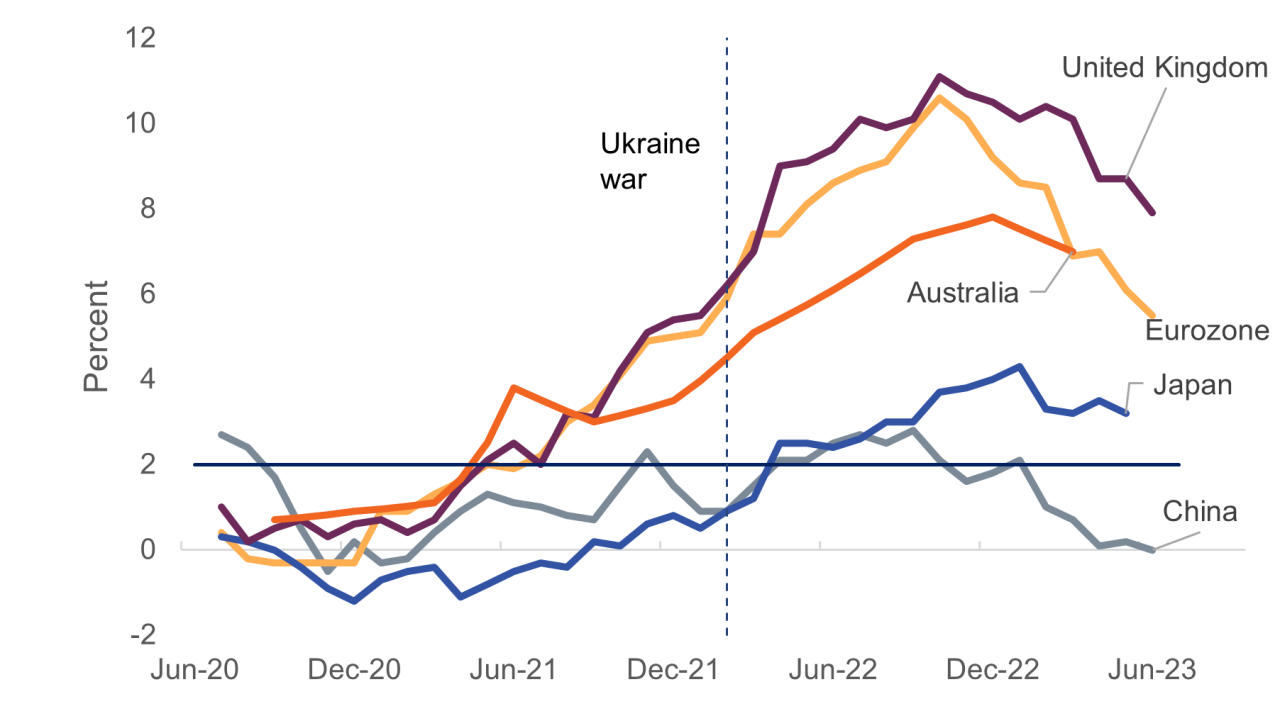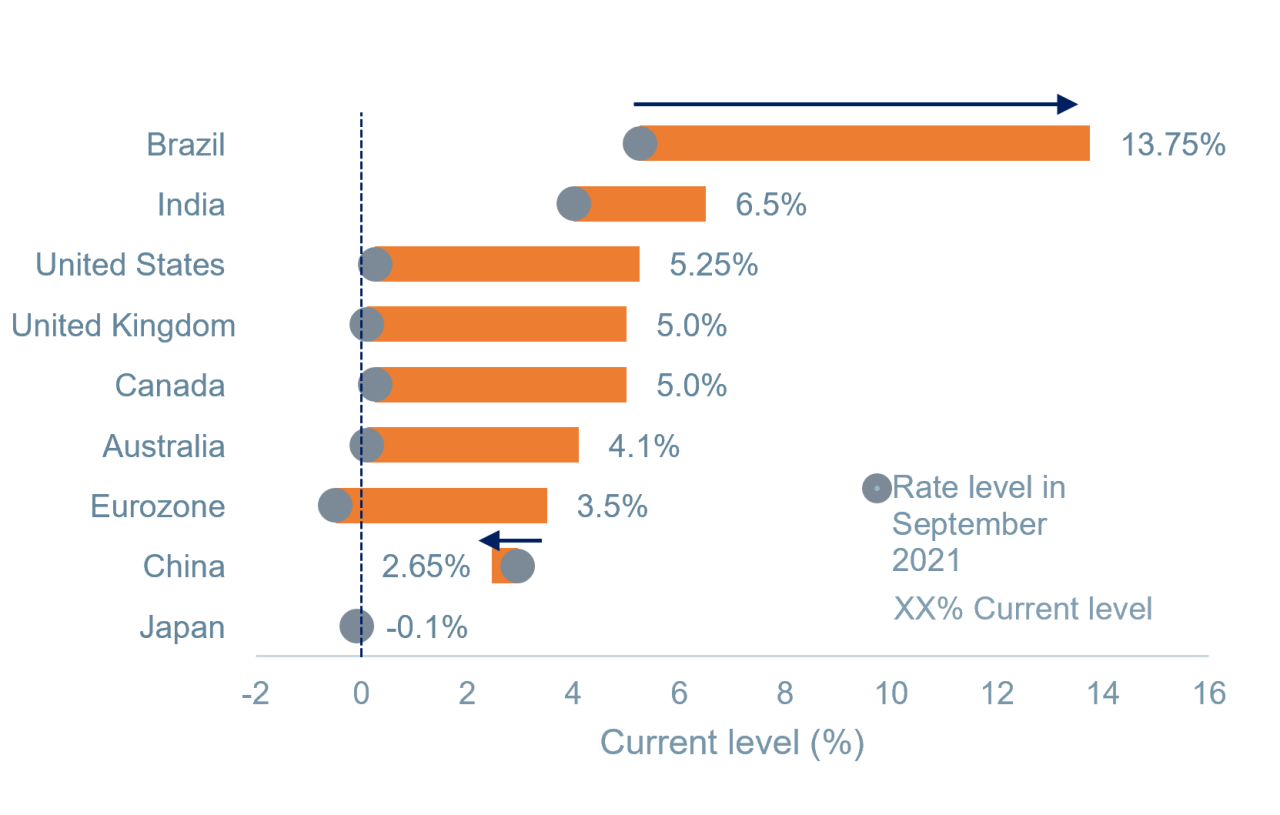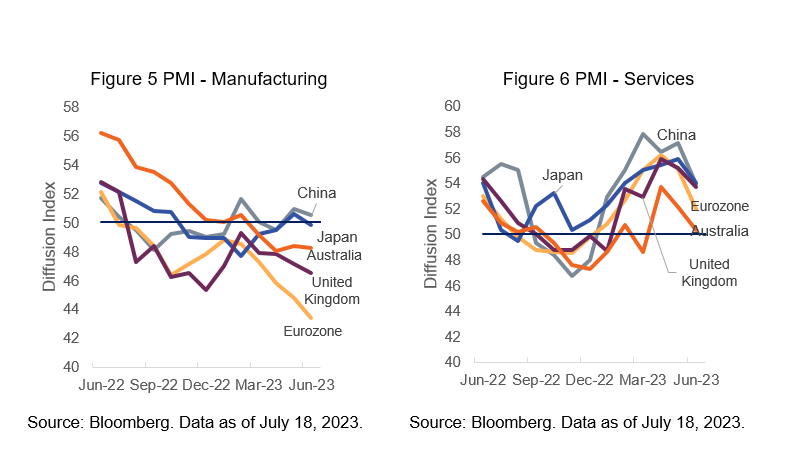 Equal Housing Lender. Bank NMLS #381076. Member FDIC.
Equal Housing Lender. Bank NMLS #381076. Member FDIC.
 Equal Housing Lender. Bank NMLS #381076. Member FDIC.
Equal Housing Lender. Bank NMLS #381076. Member FDIC.
The unprecedented interest hiking cycle by central banks around the globe continues with no end in sight—at least not in 2023—but there are divergences emerging for inflation. While inflation has come down from the highs observed last year, inflation levels remain higher than targets set by most central banks. However, the more recent inflation experience appears to be different in Asia and Europe/Australia, leading to different monetary policy expectations.
While the Bank of England (BoE), European Central Bank (ECB), and Reserve Bank of Australia (RBA) continue to signal further rate hikes to fight sticky inflation and hot labor markets, Peoples Bank of China (PBoC) has started to cut rates and Bank of Japan (BoJ) is maintaining an ultraloose monetary policy. The easier monetary policy—and in the case of China, fiscal policy—in Asia could provide support to economic growth while European/Australian economies face a downside risk from interest rates remaining high for too long. However, as many Asian economies depend on external demand for growth, a slowdown in global demand resulting from the tight monetary policy could lead to faltering Asian economies. Given the uncertainty around Europe and Asia we maintain an underweight to international developed market equities.
Inflation and central bank reaction
The initial post-COVID inflation in the summer of 2021 (as shown in Figure 1) was synchronous across countries, largely driven by the global reopening. Inflation continued to rise through 2021 and accelerated after the invasion of Ukraine due to sharp increases in food and energy prices—particularly wheat and natural gas. Although the commodity prices provided an impetus to global inflation, the impact was more pronounced in Europe which was heavily dependent on natural gas imports from Russia. China and Japan also experienced price acceleration but overall inflation stayed lower, likely due to differing experiences in terms of softer pent-up demand and labor market conditions.
Figure 1 Global Inflation (y/y)

Source: Bloomberg. Data as of July 18, 2023.
Australia quarterly CPI only available till March 2023.
Central banks responded with unprecedented monetary tightening (see Figure 2). For example, the ECB raised their deposit rate (a key ECB interest rate) by 400 basis points (bps) from -0.5% in June 2022 to 3.5% by June 2023—the highest increase in its 25-year history—in a span of a year. Similarly, the BoE and RBA have increased their policy rates by 490 and 400 bps, respectively. In contrast, the BoJ has maintained its policy rate at -0.1% while PBoC (which uses several different interest rates for policy) has been loosening policy, cutting the required deposit reserve ratio from 12.5% in June 2021 to 10.75% now. Similarly, the medium-term lending rate was cut from 2.95% in January 2022 to 2.65% currently.
Figure 2 Central Bank Hikes

Source: Bloomberg. Data as of July 18, 2023. China is represented by the 1-year medium-term lending rate.
The unprecedented monetary tightening is starting to have the desired impact of slowing down aggregate demand and reducing inflation. However, inflation remains sticky at levels above central bank targets and many central banks—including the Fed, BoE, and ECB—have indicated that they expect to maintain the tight monetary policy conditions for longer with continued monetary tightening as needed.
Output response to monetary policy tightening
Central banks are running a tight rope between bringing inflation to target and avoiding a recession. The timing of when they start to ease monetary policy is going to be crucial in determining whether the economies end up with a “soft landing” or a recession. The different inflation experience means that while growth is celebrated in low inflation countries like Japan and China, it leads to trepidation in high inflation regions.
As shown in Figure 3, Australia, the Eurozone, and the United Kingdom appear to be slowing down; in fact, the Eurozone is already in a technical recession—defined as two successive quarters of negative GDP growth. However, surveys of companies, reflected in purchasing manager indices (PMIs), are presenting a more mixed picture. Service PMIs point to healthy growth—any number above 50 indicates an expansion—while manufacturing surveys point to a decline, the sharpest of which is in the Eurozone with the lowest reading since the pandemic.


Unemployment rates also remain low and, in fact, continue to decline in some areas like the Eurozone. Tight labor markets are putting pressure on wage growth and fueling fear of a wage-price spiral, particularly in the service sector. The mixed news on growth along with the apparent imbalance in the labor market means that the fight against inflation in Europe is likely to be long and hard-fought, making it difficult to avoid a recession.
In contrast, Japan surprised with GDP growth of 2.7% in 1Q 2023—higher than expectation. PMIs as well as the recently released BoJ’s Tankan survey results—a quarterly survey of short-term economic sentiments of enterprises—continue to point to growth. The wage growth also surprised at 2.5% compared to an expectation of 1.2%. The high wage growth along with higher inflation is good news for the BoJ, which has been trying to bring inflation up to its target level by running a long-term, ultra-loose monetary policy.
China has also consistently reported high GDP growth since reopening with the most recent reading of 6.3% for 2Q 2023 compared to 4.5% in 1Q 2023. The PMIs for China continue to point to an expansion but have been lower over the past few readings. However, there are some signs the growth may be losing momentum with exports (in dollar terms y/y) declining by 12.4% compared to 7.5% in May. The tepid data are fueling expectations of further monetary and fiscal stimulus in China.
Downside risks
The optimistic scenario is that inflation in Europe and Australia (along with the U.S. and Canada) continues to slow and central banks can ease off on monetary policy leading to a “soft landing.” This could be supported by output growth in China which has been a source of global disinflation through its cheaper exports. Growth in the rest of Asia, including Japan and India, could also provide an impetus to global growth.
However, there are a few considerations that could derail this optimistic scenario. First, interest rates could remain too high for too long leading to a global recession. Second, inflation may remain high due to continuing labor market tightness or geopolitical events (e.g., continuing war in Ukraine, U.S./China trade tensions, or reshoring of supply chains). Third, Japan could struggle to maintain the inflation and high growth and falls back into the long-term low-growth and low inflation scenario. Finally, the underlying risks in the property market and local government borrowing could come to a head in China, leading to a major slowdown.
Core narrative
The inflation experience and monetary policy response has been markedly different in Europe/Australia compared to Asia. While ECB, BoE, and RBA have been trying to tame inflation and slow down the economy by hiking rates, the BoJ and PBoC are struggling to maintain growth and keep inflation high by either maintaining or loosening monetary policy. In Europe/Australia, there is a risk that higher rates remain high for too long, leading to a global slowdown. While in Japan and China, the risk is that the growth is short lived and the economies falter due to spillovers from a wider global slowdown. The risk of a global slowdown remains high and brings downside risk to the performance of international developed equities. We hold an underweight to equities, both in U.S. small-cap and international developed asset classes, and an overweight to cash and fixed income.
Definitions
Basis points refers to a common unit of measure for interest rates and other percentages in finance. One basis point is equal to 1/100th of 1%, or 0.01%, or 0.0001, and is used to denote the percentage change in a financial instrument.
Global PMI diffusion refers to the proportion of countries with expanding manufacturing activities (PMI over 50). Global PMI diffusion year-over-year reflects the proportion of countries with increasing PMI (year-over-year over 0).
Facts and views presented in this report have not been reviewed by, and may not reflect information known to, professionals in other business areas of Wilmington Trust or M&T Bank who may provide or seek to provide financial services to entities referred to in this report. M&T Bank and Wilmington Trust have established information barriers between their various business groups. As a result, M&T Bank and Wilmington Trust do not disclose certain client relationships with, or compensation received from, such entities in their reports.
The information on Wilmington Wire has been obtained from sources believed to be reliable, but its accuracy and completeness are not guaranteed. The opinions, estimates, and projections constitute the judgment of Wilmington Trust and are subject to change without notice. This commentary is for informational purposes only and is not intended as an offer or solicitation for the sale of any financial product or service or a recommendation or determination that any investment strategy is suitable for a specific investor. Investors should seek financial advice regarding the suitability of any investment strategy based on the investor’s objectives, financial situation, and particular needs. Diversification does not ensure a profit or guarantee against a loss. There is no assurance that any investment strategy will succeed.
Past performance cannot guarantee future results. Investing involves risk and you may incur a profit or a loss.
Indexes are not available for direct investment. Investment in a security or strategy designed to replicate the performance of an index will incur expenses such as management fees and transaction costs which will reduce returns.
Reference to the company names mentioned in this blog is merely for explaining the market view and should not be construed as investment advice or investment recommendations of those companies. Third party trademarks and brands are the property of their respective owners.
The gold industry can be significantly affected by international monetary and political developments as well as supply and demand for gold and operational costs associated with mining.
Stay Informed
Subscribe
Ideas, analysis, and perspectives to help you make your next move with confidence.
What can we help you with today